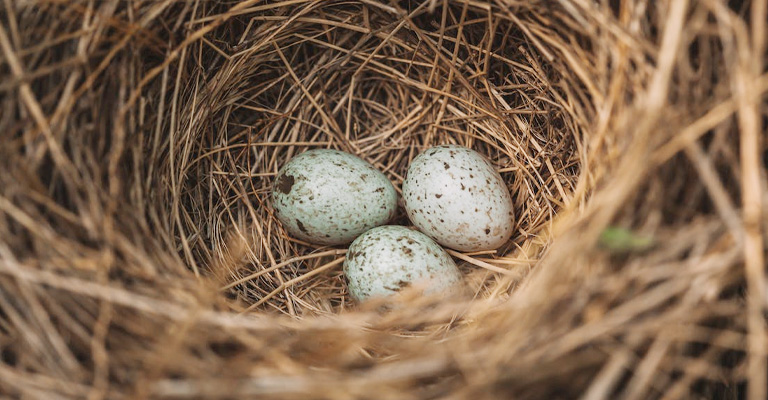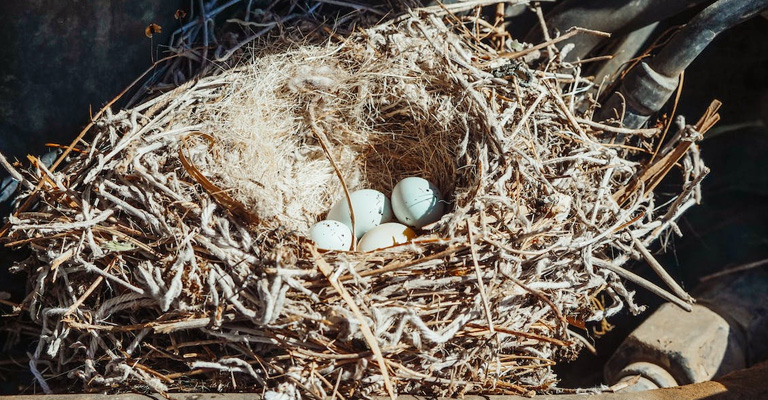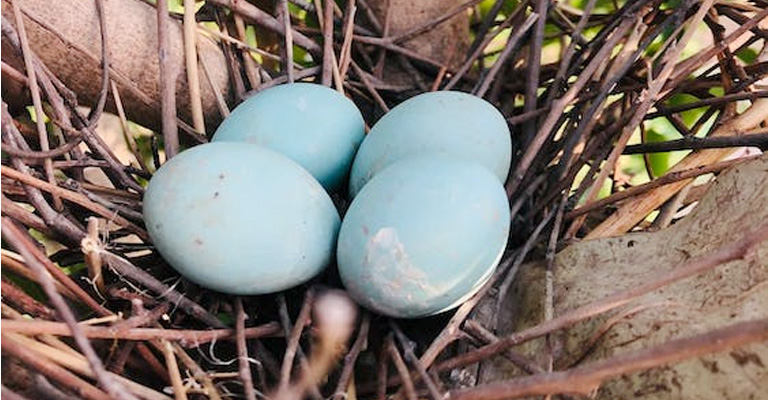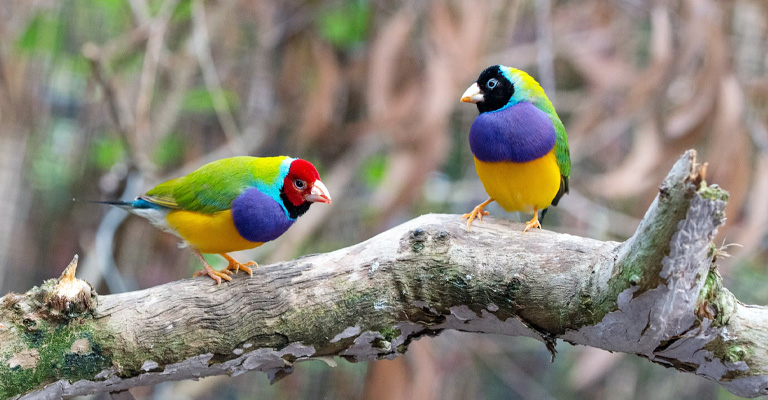Birds are remarkable creatures that can produce eggs without the need for fertilization or mating. Their eggs come in different shapes, sizes, colors, and patterns, reflecting their diversity and adaptation to their environment.
But how often do wild birds lay eggs? What factors influence their egg-laying frequency and quantity? How do they ensure the survival and success of their offspring?
In this article, we will explore the answers to these questions, as well as the basics of bird reproduction, the types and functions of bird eggs, the variations and similarities among bird species, and the challenges and threats that birds face in their egg-laying process. We will also answer some frequently asked questions about this topic.

Basics of Bird Reproduction
Birds reproduce by laying eggs that contain their genetic material and a supply of nutrients for their developing embryos.
Unlike mammals, birds do not have external sex organs or internal wombs. Instead, they have a single opening called the cloaca, which serves as the exit for both reproductive and excretory products.
To produce eggs, birds need to undergo a series of physiological and behavioral changes that are regulated by hormones and environmental cues. These include:
Oogenesis
This is the process of forming and maturing egg cells (ova) in the female bird’s ovaries. Most female birds have only one functional ovary (usually the left one), which contains thousands of ova at various stages of development. Each ovum is surrounded by a thin membrane called the follicle, which produces hormones that stimulate egg production.
Ovulation
This is the process of releasing a mature ovum from the ovary into the oviduct (a tube that connects the ovary to the cloaca). Ovulation usually occurs once a day during the breeding season, triggered by factors such as daylight length, temperature, and food availability.
The timing of ovulation can vary among species and individuals, but it typically occurs in the morning or early afternoon.
Fertilization

This is the process of joining a male bird’s sperm cell with a female bird’s ovum to form a zygote (a fertilized egg cell). Fertilization can occur either internally or externally, depending on the species and mating system.
Internal fertilization occurs when a male bird inserts his cloaca into a female bird’s cloaca and transfers his sperm during copulation. External fertilization occurs when a male bird releases its sperm over a female bird’s eggs after she lays them.
Egg formation:
This is the process of adding layers of material around the zygote to form an egg. The egg formation takes place in different sections of the oviduct, each with a specific function. The sections are:
Infundibulum: This is where fertilization takes place if it is internal. It also adds a thin layer of albumen (egg white) around the zygote.
Magnum: This adds more layers of albumen around the zygote.
Isthmus: This adds two shell membranes around the albumen.
Uterus: This adds the calcareous shell (the hard outer layer) and pigments (the color) around the shell membranes.
Vagina: This stores the egg until it is ready to be laid.
Egg laying: This is the process of expelling an egg from the oviduct through the cloaca. Egg laying usually occurs within 24 hours after ovulation, but it can vary depending on the species and environmental conditions. Some birds lay one egg per day until they complete their clutch (a set of eggs laid in one nesting cycle), while others lay multiple eggs per day or at irregular intervals.
Types and Functions of Bird Eggs

Bird eggs are not only reproductive products but also protective structures that ensure the survival and development of their embryos. Bird eggs have different types and functions depending on their shape, size, color, and pattern. These include:
Shape
Bird eggs can have different shapes ranging from spherical to elliptical to pyriform (pear-shaped). The shape of an egg affects its stability, heat retention, and water loss.
For example, spherical eggs are more stable and less likely to roll away, but they also have less surface area and more volume, which means they lose heat and water faster than elliptical eggs.
Elliptical eggs are less stable but have more surface area and less volume, which means they retain heat and water better than spherical eggs.
Pyriform eggs are intermediate between spherical and elliptical eggs, but they also have a pointed end that helps them fit in narrow spaces or wedge in crevices.
Size
Bird eggs can vary in size from less than 1 cm (0.4 in) in length for hummingbirds to more than 15 cm (6 in) in length for ostriches. The size of an egg affects its incubation time, hatchling size, and parental care.
For example, larger eggs take longer to incubate and hatch, but they also produce larger and more developed hatchlings that require less parental care.
Smaller eggs take shorter to incubate and hatch, but they also produce smaller and less developed hatchlings that require more parental care.
Color

Bird eggs can have different colors ranging from white to brown to blue to green. The color of an egg affects its camouflage, thermoregulation, and signaling.
For example, white eggs are more camouflaged in dark or enclosed nests, but they also reflect more sunlight and heat, which can be beneficial or detrimental depending on the ambient temperature.
Colored eggs are more camouflaged in open or vegetated nests, but they also absorb more sunlight and heat, which can be beneficial or detrimental depending on the ambient temperature.
Colored eggs can also signal information to other birds, such as the quality of the nest site, the identity of the parents, or the presence of parasites.
Pattern
Bird eggs can have different patterns ranging from plain to speckled to spotted to streaked. The pattern of an egg affects its camouflage, recognition, and signaling.
For example, plain eggs are less camouflaged but more recognizable by their parents, which can prevent brood parasitism (the practice of laying eggs in another bird’s nest) or egg dumping (the practice of laying extra eggs in another bird’s nest).
Patterned eggs are more camouflaged but less recognizable by their parents, which can facilitate brood parasitism or egg dumping. Patterned eggs can also signal information to other birds, such as the age of the egg, the health of the parent, or the sex of the embryo.
Variations and Similarities among Bird Species

Birds are a diverse group of animals that have evolved different strategies and adaptations for their egg-laying process. Depending on their species, birds can vary in their egg-laying frequency, quantity, timing, location, and behavior. Some examples of these variations are:
Frequency:
Birds can lay eggs at different frequencies depending on their reproductive strategy and environmental conditions. Some birds lay eggs only once a year, such as eagles or swans. Some birds lay eggs several times a year, such as chickens or ducks. Some birds lay eggs continuously throughout the year, such as pigeons or parrots.
Quantity:
Birds can lay different numbers of eggs depending on their clutch size and nesting cycle. Some birds lay only one egg per clutch, such as kiwis or albatrosses. Some birds lay several eggs per clutch, such as songbirds or seabirds. Some birds lay dozens of eggs per clutch, such as quails or pheasants.
Timing:
Birds can lay eggs at different times depending on their circadian rhythm and seasonal cycle. Some birds lay eggs in the morning, such as chickens or robins. Some birds lay eggs in the afternoon, such as parrots or hummingbirds. Some birds lay eggs at night, such as owls or nightjars.
Location:
Birds can lay eggs in different locations depending on their habitat and nesting preference. Some birds lay eggs in trees or shrubs, such as woodpeckers or warblers. Some birds lay eggs on the ground or rocks, such as penguins or gulls. Some birds lay eggs in cavities or burrows, such as kingfishers or puffins.
Behavior
Birds can exhibit different behaviors before, during, and after laying eggs depending on their mating system and parental care. Some birds are monogamous and share the duties of incubating and feeding the eggs and young, such as swans or penguins.
Some birds are polygamous and leave the duties of incubating and feeding the eggs and young to one partner or none at all, such as peacocks or cuckoos.
Some birds are cooperative breeders and receive help from other members of their group in incubating and feeding the eggs and young, such as meerkats or hornbills.
Despite these variations among bird species, there are also some similarities that reflect their common ancestry and physiology. These include:
Sex Chromosomes
Birds have two sex chromosomes that determine their sex: Z and W. Male birds have two Z chromosomes (ZZ), while female birds have one Z and one W chromosome (ZW).
This means that female birds are the heterogametic sex (the sex that produces two types of gametes) and male birds are the homogametic sex (the sex that produces one type of gamete). This is opposite to mammals, where males are XY and females are XX.
Eggshell Structure
Birds have a similar eggshell structure that consists of three layers: the cuticle, the calcareous layer, and the shell membranes. The cuticle is the outermost layer that protects the egg from water loss, bacterial infection, and mechanical damage. The calcareous layer is the middle layer that provides strength and rigidity to the egg.
It is composed of calcium carbonate crystals arranged in a honeycomb pattern. The shell membranes are the innermost layer that surrounds the albumen and the yolk. They are composed of keratin fibers that allow gas exchange and prevent microbial invasion.
Incubation Period
Birds have a similar incubation period that ranges from 10 to 30 days, depending on the species and environmental conditions. The incubation period is the time between laying an egg and hatching a chick. During this period, birds keep their eggs warm and moist by sitting on them or covering them with their feathers or body heat.
They also turn their eggs periodically to ensure even development and prevent sticking to the shell. The incubation period ends when the chick breaks out of the shell using its egg tooth (a temporary structure on its beak).
FAQs
Wild birds typically lay eggs once or twice a year, depending on the species and environmental factors. Some species, such as songbirds, may have multiple broods in a single breeding season, while others, like larger raptors, may only have one clutch of eggs per year.
No, not all wild birds lay eggs every year. Breeding frequency varies among species, and some birds may skip breeding in certain years due to factors like food scarcity, unfavorable weather conditions, or insufficient resources for raising offspring.
The age at which wild birds start laying eggs can vary widely depending on the species. Smaller birds, like songbirds, may reach reproductive maturity and start laying eggs when they are one year old. Larger birds, such as eagles or herons, may take several years, typically three to five, to reach sexual maturity and start breeding.
The number of eggs laid by wild birds can vary depending on the species. Smaller birds tend to lay fewer eggs, usually between 2 to 6 eggs per clutch. Larger birds, like waterfowl or birds of prey, may lay larger clutches, ranging from 1 to 12 eggs. The specific number of eggs laid also depends on factors such as habitat conditions, the availability of resources, and the bird’s reproductive strategy.
Not all wild bird eggs hatch successfully. The hatching success can be influenced by various factors, including predation, parasitism by brood parasites (like cuckoos), adverse weather conditions, disease, or infertility of the eggs.
Additionally, the incubation period requires specific temperature and humidity conditions, which, if not met, can result in unsuccessful hatching.
Conclusion
Wild birds lay eggs once or twice a year, but this can vary depending on the species and environmental factors. Breeding frequency, number of eggs laid, and hatching success can be influenced by various factors, including species characteristics, habitat conditions, and availability of resources.
Understanding the breeding patterns and behaviors of wild birds is important for their conservation and management, as it helps us identify factors that may affect their reproductive success.
Studying and protecting their nesting sites, addressing threats like habitat loss or climate change, and ensuring the availability of food resources are crucial steps in preserving these beautiful creatures and their remarkable reproductive cycles.